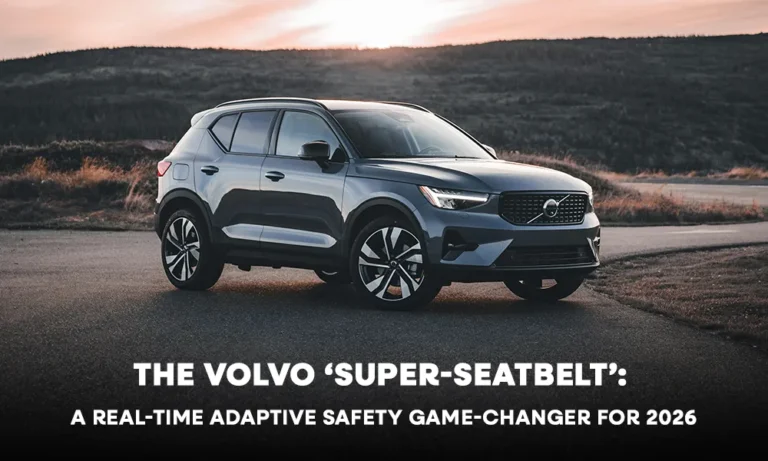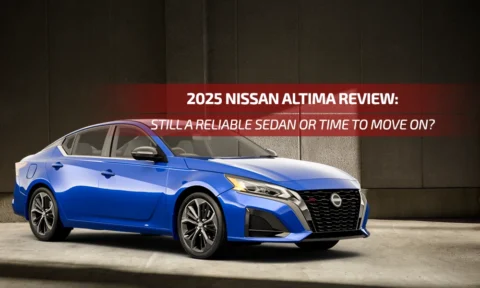As far as I can remember, the Volvo brand has always been associated with safety. After all, it is the brand that came up with the three-point seatbelt safety feature in its cars that has been adopted by all car manufacturers today, saving millions of lives. Essentially, they have been keeping car drivers safe for decades and are constantly pushing for better crash protection.
They’ve been setting the bar for how carmakers think about protecting passengers. Now they’re taking things to the next level and are set to debut their latest adaptive seatbelt, which actually adjusts in real time.
Let us get the details.
What’s Special About This New Seatbelt?
Traditionally, seatbelts are meant to perform one main job: to restrain you in case of an impact, so you don’t end up smashing your head into the dashboard, or even worse, go flying through the windshield. They lock when the car jerks suddenly, and pretensioners tighten during a crash.
But Volvo’s new system goes a step further. This new multi-adaptive seatbelt is packed with sensors that communicate directly with the car’s safety systems. It can tighten, loosen, or shift its grip based on how the car is moving, the position, posture, and size of the passenger, and even the severity of the situation.
Imagine driving over rough city streets, then suddenly slamming the brakes to avoid a cyclist or a dog that darts across the road. In a normal car, your belt would only lock when things get drastic. With Volvo’s new system, the belt reacts earlier and smarter. It can brace you gently for a sudden stop without making you feel uncomfortable.
Why This Matters for Drivers and Passengers
What I really liked about the system was how personalized it seemed. The belt doesn’t just react to the car; it reacts to you as an individual, your posterior, height, and even your body weight. If it senses you leaning forward or sitting at an angle, it adjusts so the restraint functions more effectively in that position. This could make a big difference for kids, elderly passengers, or anyone who doesn’t sit perfectly upright the whole time.
It also works hand-in-hand with other safety features. Say your car’s collision avoidance system detects a possible crash. Volvo’s new seatbelt would tighten instantly, even before impact, working together with the airbags and braking to keep you safer.
How the Seatbelt Works in Everyday Scenarios
Let’s look at how the seat belt could help when you’re actually behind the wheel.
- Stop-and-Go Traffic: When navigating congested city traffic, the belt can subtly adjust during small jolts to keep you secure without the sharp pull you would usually feel when your seat belt tightens.
- Sudden Braking: If you slam the brakes suddenly, the system pre-tightens the belt even before your car comes to a full stop, giving you a more controlled restraint.
- Sharp Turns: When the car senses a rapid turn, the belt grips you just enough to keep your body aligned with the seat, helping you stay stable and not lean toward the side along with the car.
- Highway Cruising: On long highway stretches, the belt relaxes slightly, letting you sit comfortably without losing its protective hold around you.
- Pre-Crash Situations: If the sensors on the belt detect that you are heading for a collision, the belt stiffens instantly within a split second, before the impact happens.
This offers a much better balance between comfort and safety, making the belt feel less like a constraint and more like a companion who’s got your back.
Which Volvo Models Will Get It First?
Volvo hasn’t released the full list yet, but early reports suggest the EX90 electric SUV will be the first to carry this technology when it launches in 2026. From there, it’s expected to roll out across other new-generation electric models like the EX30 and future hybrid SUVs. Since Volvo tends to bring its big safety updates to the entire lineup over time, there’s a good chance this won’t stay limited to premium cars for long.
FAQs on The Volvo Super-Seatbelt
It’s a next-gen seatbelt with built-in sensors that can tighten, loosen, or adjust in real time, depending on the driving situation and passenger position.
Regular belts mostly lock during sudden stops. Volvo’s version interacts with the car’s safety systems, prepping before an accident and adapting continuously—even during normal driving.
The system is expected to debut in the EX90 electric SUV in 2026, with other models like the EX30 following soon after.
Yes. It connects with Volvo’s collision avoidance, braking, and airbag systems, ensuring everything works together in real time.
Volvo usually shares safety advances across its entire lineup, so while it may start in premium EVs, it will likely reach broader models in the future.
Looking Ahead to 2026
Once Volvo introduces this cutting-edge technology in its upcoming models by 2026, I think it’s going to create a ripple effect across the industry, with other car brands scrambling to develop something similar. Much like how their original seatbelt design became standard worldwide, we might look back at this in ten years and wonder how we ever drove without it.
The Bigger Picture
Volvo’s super seat belt isn’t just about one feature. It’s also an indication of how car safety is becoming more intelligent and personalized. Cars are no longer merely reliant on their steel shells to protect us from impact. They’re increasingly becoming smart systems that sense, adapt, and react based on our safety needs in real time. And Volvo, true to its DNA, is once again leading the charge.
Learn about the newest innovations in the automotive industry exclusively at Ask About Cars.






